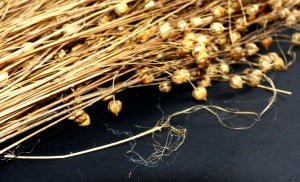Fabric & fibre, Faxipedia, Flax Museum, Flaxfarm, History, Materials
Traditional flax production for linen
Prior to industrialisation even small farmers grew flax to produce linen for their own needs from home grown flax. In the UK and other Northern Europe countries linen was the only widely available alternative to wool until cotton became available. The flax used for linen production usually comes from slightly different varieties of the species of Linum usitatissimum than linseed or flax for human consumption. It is also harvested differently.

Flax and traditional linen production: ancient Russian instruments and the materials they were used on in the traditional production of linen from flax plants and their fibre.(Booth Pinezhsky Museum). 1-beater, 2-fiber after scutching Llano, Llano 3-fiber tow after the first 4-Llano after the second fiber tow, tow 5, 6 -Taylor (canvas threads from Llano), 7 – row (from hemp canvas threads), 8, 9 – Brushes for Sanchez flax and hemp, 10-comb for cleaning flax and hemp, 12, abusive pattern. Photo 3 November 2006. Photo by Schekinov Alexey Victorovich November 3 2006
The simple equipment was typically homemade and everything from growing to harvesting, scutching to spinning and weaving was carried out by the family.

Traditional flax growing and linen production is written about and illustrated in “How a Shirt Grew in the Field”, a children’s book, originally in Russian.

